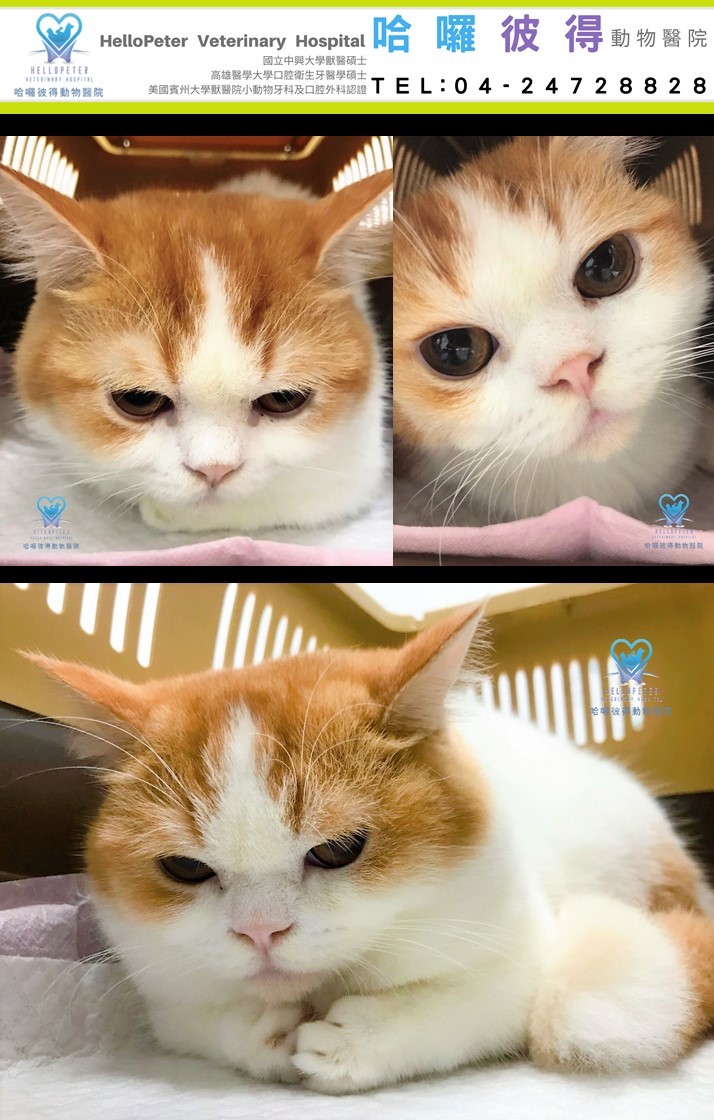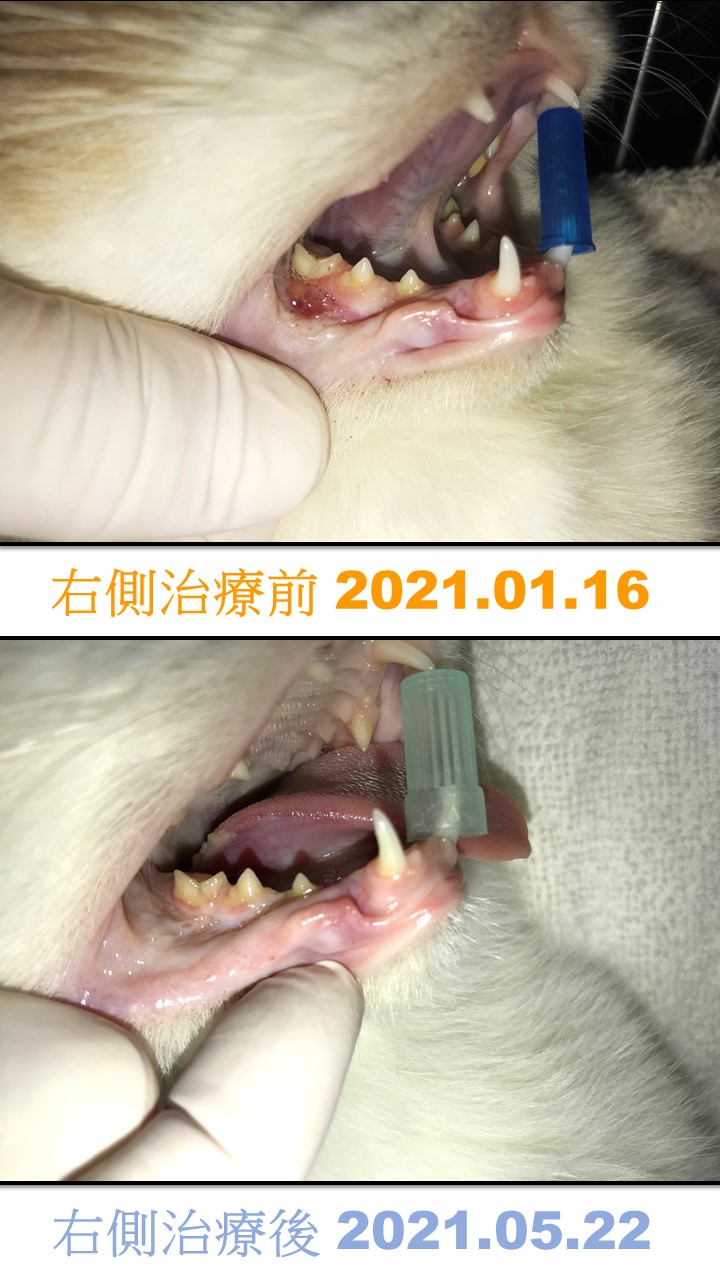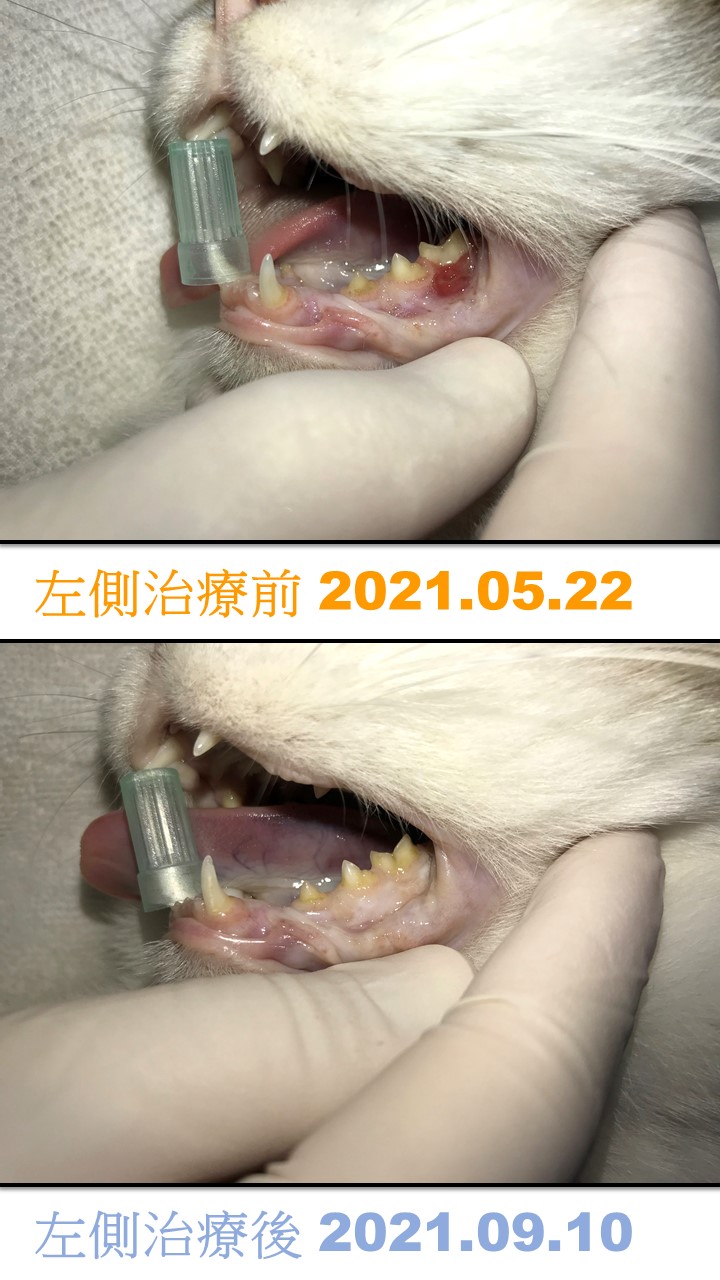Occlusal trauma (trauma from occlusion or occlusal traumatism) in brachycephalic cat.
 Mang-Bao is a two-year-old Munchkin male cat. Soon after he completed the growth of permanent teeth, the owner discovered that the patient’s mouth had an unidentified red bump (granuloma), they were next to the first molars of the mandibular on both sides. The owner had tried many kinds of treatments, such as surgical removal of granulomas and various medicines, but the same place was repeatedly swollen, the cat even began to have symptoms such as eating slowly, shaking head, mouth digging, etc., so the owner brought the cat to my hospital for the first time when the patient was one year old. At the first dental clinic, the patient was diagnosed with occlusal trauma (also called “trauma from occlusion” or “occlusal traumatism”) which was caused by malocclusion, and then this caused traumatic granulomas.。
Mang-Bao is a two-year-old Munchkin male cat. Soon after he completed the growth of permanent teeth, the owner discovered that the patient’s mouth had an unidentified red bump (granuloma), they were next to the first molars of the mandibular on both sides. The owner had tried many kinds of treatments, such as surgical removal of granulomas and various medicines, but the same place was repeatedly swollen, the cat even began to have symptoms such as eating slowly, shaking head, mouth digging, etc., so the owner brought the cat to my hospital for the first time when the patient was one year old. At the first dental clinic, the patient was diagnosed with occlusal trauma (also called “trauma from occlusion” or “occlusal traumatism”) which was caused by malocclusion, and then this caused traumatic granulomas.。

 Occlusal trauma refers to the inflammation, redness and destruction of periodontal tissue due to abnormal or excessive occlusal force. Long-term inflammation and irritation may even lead to the loss of alveolar bone or tooth absorption at the root of the tooth, and because it is caused by abnormal occlusion, medicines will not have a therapeutic effect.
Occlusal trauma refers to the inflammation, redness and destruction of periodontal tissue due to abnormal or excessive occlusal force. Long-term inflammation and irritation may even lead to the loss of alveolar bone or tooth absorption at the root of the tooth, and because it is caused by abnormal occlusion, medicines will not have a therapeutic effect.
There are two types of occlusal trauma:
1. Primary occlusal trauma--periodontal tissue injury caused by abnormal or excessive occlusal force acting on the originally healthy periodontal tissue.
2. Secondary occlusal trauma--due to periodontal disease, the ability of the periodontal tissue to support the tooth is loss, and the patient is unable to withstand the original occlusal force anymore, resulting in occlusal trauma.
Mang-Bao is a primary occlusal trauma patient. Because of the malocclusion, traumatic granulomas are produced on the gingiva of the first molars of the mandibular on both sides (309, 409). Resection of the granulomas is not enough for the treatment. The fourth premolars of the maxillary on both sides (108, 208) will continue to irritate the wound after surgery due to the malocclusion, and then repeatedly produce new traumatic granulomas in the original position. There are many pstients of occlusal trauma in cats, if the cat is a flat-faced breed, the insufficient dental arch space and are prone to malocclusion caused by crowded space, and the probability of occlusal trauma is higher than other breeds.
Adjusting the occlusion is the most important point in treatment. In this patient, I polished the tips of the 108 and 208 morsal surfaces, so that the gingiva on the buccal side of the mandibular are no longer irritated. I also removed the granulomas at the same time, all problems of occlusal trauma are finally solved. Now Mang-Bao will no longer shake his head for no reason, never use his hands to dial the mouth again. The owner finally doesn’t need to bring him to my hospital every month.
Remarks: In this patient, occlusal trauma occurred first on the right buccal side. After the right buccal side was healed on May 22, 2021, the same occlusal trauma was found on the left buccal side, and finally healed the lesion on September 10, 2021.
References:
Gracis, M., Molinari, E., & Ferro, S. (2015). Caudal mucogingival lesions secondary to traumatic dental occlusion in 27 cats: macroscopic and microscopic description, treatment and follow-up. J Feline Med Surg, 17(4 ), 318-328. doi:10.1177/1098612X14541264
Greenstein, G., Cavallaro, J., Scharf, D., & Tarnow, D. (2008). Differential diagnosis and management of flared maxillary anterior teeth. J Am Dent Assoc, 139(6), 715-723. doi: 10.14219/jada.archive.2008.0253
HelloPeter Veterinary Hospital
Phone: +886-4-2472-8828 Veterinary Dentistry & Oral Surgery
Official Website:
www.hellopeter.com.tw
Facebook:
https://www.facebook.com/vet.dentistry.oral.medicine/ @vet.dentistry.oral.medicine
Instagram: @hellopeter_ah
Hospital Hours: Monday to Friday 10:00~20:00 (by appointment only), 12:00 to the end of all appointments on Saturday, Closed on Sunday
【Hard Tissue】(All surgeries at our hospital are performed using German ZEISS dental microscopes)
▲Minimally invasive extraction with piezosurgery
▲ Full-mouth comprehensive scaling, dental X-rays, root planing, periodontal examination, and polishing
▲ Microscopic endodontics
▲Dental crowns and bridges produced with 3D printing
▲Guided Tissue Regeneration (GTR)
▲Guided Bone Regeneration (GBR)
▲Dental restorations (fillings)
▲Dental implants for dogs & cats
▲Orthodontics for dogs & cats, rabbit dentistry (teeth trimming & orthodontics)
▲Maxillofacial bone fractures (intermaxillary fixation and osteotomy)
【Soft Tissue】(All surgeries at our hospital are performed using German ZEISS dental microscopes)
★Innovative Mucogingival Replacement Surgery (MGRS) for treating stomatitis in dogs and cats
▲ Periodontal disease treatment for dogs & cats
▲Dental pulp therapy for dogs & cats
▲Oronasal fistula treatment
▲Oral tumor surgery
▲Odontogenic abscesses treatment for rabbits
#陳重威獸醫師 #哈囉彼得動物醫院 #HellPeterVeterinaryHospital #動物牙科推薦 #寵物牙科推薦 #牙齦黏膜置換手術 #mucogingivalreplacementsurgery #mgrs #貓 #貓口炎 #口炎貓 #口炎貓口腔治療研究計畫 #cat #dog
#動物口腔外科 #獸醫牙科 #pet





